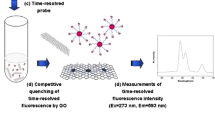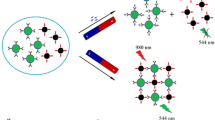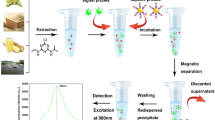Abstract
We demonstrate an ultrasensitive time-resolved fluorescence immunoassay for bisphenol A (BPA) where gold nanoparticles (Au-NPs) were modified with anti-BPA antibody and thiolated dsDNA-biotin acting as a signal amplifier. In a competitive reaction, the analyte (BPA) competes with immobilized BPA-ovalbumin conjugate on the surface of microtiter plates to bind to the anti-BPA antibodies on the surface of the Au-NPs. In the next step, a Eu(III)-labeled streptavidin is added to link to the SH-dsDNA-biotin as a tracer. Fluorescence is amplified via both the Au-NPs and the biotin-streptavidin systems, and its intensity is measured in a time-resolved fluorescence immunoassay. The linear range is from 1.0 fg∙mL−1 to 1.0 ng∙mL−1, and the detection limit is 0.3 fg mL−1, respectively. The method was applied to the determination of BPA in spiked water sample, with recoveries ranging from 90.2 to 106.4 %.

A time-resolved fluorescence immunoassay based on the functionalized gold nanoparticles as signal amplifier was constructed for BPA detection.




Similar content being viewed by others
References
Hengstler JG, Foth H, Gebel T, Kramer PJ, Lilienblum W, Schweinfurth H, Völkel W, Wollin KM, Gundert-Remy U (2011) Critical evaluation of key evidence on the human health hazards of exposure to bisphenol A. Crit Rev Toxicol 41(4):263–291
Vandenberg LN, Chahoud I, Heindel JJ, Padmanabhan V, Paumgartten FJ, Schoenfelder G (2010) Urinary, circulating, and tissue biomonitoring studies indicate widespread exposure to bisphenol A. Environ Health Perspect 118:1055–1070
Vandenberg LN, Maffini MV, Sonnenschein C, Rubin BS, Soto AM (2009) Bisphenol-A and the great divide: a review of controversies in the field of endocrine disruption. Endocr Rev 30(1):75–95
Rudel RA, Gray JM, Engel CL, Rawsthorne TW, Dodson RE, Ackerman JM, Rizzo J, Nudelman JL, Brody JG (2011) Food packaging and bisphenol A and bis (2-ethyhexyl) phthalate exposure. findings from a dietary intervention. Environ Health Perspect 119(7):914–920
Vandenberg LN, Hauser R, Marcus M, Olea N, Welshons WV (2007) Human exposure to bisphenol A (BPA). Reprod Toxicol 24(2):139–177
Lim DS, Kwack SJ, Kim KB, Kim HS, Lee BM (2009) Potential risk of bisphenol A migration from polycarbonate containers after heating, boiling, and microwaving. J Toxicol Environ Health A 72:1285–1291
Nakajima Y, Goldblum RM, Midoro-Horiuti T (2012) Fetal exposure to bisphenol A as a risk factor for the development of childhood asthma: an animal model study. Environ Health 11:8
Huang QS, Fang C, Chen YJ, Wu XL, Ye T, Lin Y (2011) Embryonic exposure to low concentration of bisphenol A affects the development of Oryzias melastigm alarvae. Environ Sci Pollut Res 19(7):2506–2514
Cho H, Kim SJ, Park H, Oh M, Yu SY, Lee SY, Park C, Han J, Oh J, Hwang SY, Yoon S (2010) A relationship between miRNA and gene expression in the mouse Sertoli cell line after exposure to bisphenol A. BioChip J 4(1):75–81
Poimenova A, Markaki E, Rahiotis C, Kitraki E (2010) Corticosterone-regulated actions in the rat brain are affected by perinatal exposure to low dose of bisphenol A. Neuroscience 167(3):741–749
Doherty LF, Bromer JG, Zhou Y, Aldad TS, Taylor HS (2010) In utero exposure to diethylstilbestrol (DES) or bisphenol-A (BPA) increases EZH2 expression in the mammary gland: an epigenetic mechanism linking endocrine disruptors to breast cancer. Horm Cancer 1(3):146–155
FDA update (2010) Update on bisphenol A for use in food contact applications [http://www.fda.gov/NewsEvents/PublicHealthFocus/ucm197739.htm]
Fontana AR, de Toro MM, Altamirano JC (2011) One-step derivatization and preconcentration microextraction technique for determination of bisphenol A in beverage samples by gas chromatography–mass spectrometry. J Agric Food Chem 59:3559–3565
Cunha SC, Cunha C, Ferreira AR, Fernandes JO (2012) Determination of bisphenol A and bisphenol B in canned seafood combining QuEChERS extraction with dispersive liquid–liquid microextraction followed by gas chromatography–mass spectrometry. Anal Bioanal Chem 404:2453–2463
Cunha SC, Fernandes JO (2013) Assessment of bisphenol A and bisphenol B in canned vegetables and fruits by gas chromatography–mass spectrometry after QuEChERS and dispersive liquid–liquid microextraction. Food Control 33(2):549–555
Liao C, Kannan K (2012) Determination of free and conjugated forms of bisphenol A in human urine and serum by liquid chromatography − tandem mass spectrometry. Environ Sci Technol 46:5003–5009
Zhao RS, Wang X, Yuan JP (2010) Highly sensitive determination of tetrabromobisphenol A and bisphenol A in environmental water samples by solid-phase extraction and liquid chromatography -tandem mass spectrometry. J Sep Sci 33:1652–1657
Rezaee M, Yamini Y, Shariati S, Esrafili A, Shamsipur M (2009) Dispersive liquid-liquid microextraction combined with high performance liquid chromatography-UV detection as a very simple, rapid and sensitive method for the determination of bisphenol A in water samples. J Chromatogr A 1216(9):1511–1514
Xue F, Wu J, Chu H, Mei Z, Ye Y, Liu J, Zhang R, Peng C, Zheng L, Chen W (2013) Electrochemical aptasensor for the determination of bisphenol A in drinking water. Microchim Acta 180(1–2):109–115
Feng Y, Ning B, Su P, Wang H, Wang C, Chen F, Gao Z (2009) An immunoassay for bisphenol A based on direct hapten conjugation to the polystyrene surface of microtiter plates. Talanta 80(2):803–808
Maiolini E, Ferri E, Pitasi AL, Montoya A, Giovanni MD, Errani E, Girotti S (2014) Bisphenol A determination in baby bottles by chemiluminescence enzyme-linked immunosorbent assay, lateral flow immunoassay and liquid chromatography tandem mass spectrometry. Analyst 139(1):318–324
Zhang J, Zhao SQ, Zhang K, Zhou JQ (2014) Cd-doped ZnO quantum dots-based immunoassay for the quantitative determination of bisphenol A. Chemosphere 95:105–110
Long F, Zhu A, Zhou X, Wang H, Zhao Z, Liu L, Shi H (2014) Highly sensitive and selective optofluidics-based immunosensor for rapid assessment of bisphenol A leaching risk. Biosens Bioelectron 55:19–25
Mei Z, Deng Y, Chu H, Xue F, Zhong L, Wu J, Yang H, Wang Z, Zheng L, Chen W (2013) Immunochromatographic lateral flow strip for on-site detection of bisphenol A. Microchim Acta 180:279–285
Turner M, Golovko VB, Vaughan QPH, Abdulkin P, Murcia AB, Tikhov MS, Johnson BFG, Lambert RM (2008) Selective oxidation with dioxygen by gold nanopartical catalysts derived from 55-atom clusters. Nature 454:981–983
Anker JN, Hall WP, Lyandres O, Shah NC, Zhao J, Duyne RPV (2008) Biosensing with plasmonic nanosensors. Nat Mater 7:442–453
Jans H, Huo Q (2012) Gold nanoparticle-enabled biological and chemical detection and analysis. Chem Soc Rev 41:2849–2866
Miao P, Ning LM, Li XX (2013) Gold nanoparticles and cleavage-based dual signal amplification for ultrasensitive detection of silver ions. Anal Chem 85:7966–7970
Nam JM, Stoeva SI, Mirkin CA (2004) Bio-bar-code-based DNA detection with PCR-like sensitivity. J Am Chem Soc l26:5932–5933
Parolo C, de la Escosura-Muñiz A, Polo E, Grazú V, Merkoçi JMdlFA (2013) Design, preparation, and evaluation of a fixed-orientation antibody/gold-nanoparticle conjugate as an immunosensing label. ACS Appl Mater Interfaces 5:10753–10759
Zhang B, Liu BQ, Tang DP, Niessner R, Chen GN, Knopp D (2012) DNA-based hybridization chain reaction for amplified bioelectronic signal and ultrasensitive detection of proteins. Anal Chem 84:5392–5399
Ambrosi A, Castaneda MT, Killard AJ, Smyth MR, Alegret S, Merkoçi A (2007) Double-codified gold nanolabels for enhanced immunoanalysis. Anal Chem 79:5232–5240
Stoeva SI, Lee JS, Smith JE, Rosen ST, Mirkin CA (2006) Multiplexed detection of protein cancer markers with biobarcoded nanoparticle probes. J Am Chem Soc 128:8378–8379
Nam JM, Thaxton CS, Mirkin CA (2003) Nanoparticle-based bio-bar codes for the ultrasensitive detection of proteins. Science 301:1884–1886
Costa MM, de la Escosura-Muñiz A, Nogués C, Barrios L, Ibáñez E, Merkoçi A (2012) Simple monitoring of cancer cells using nanoparticles. Nano Lett 12:4164–4171
Grabar KC, Freeman RG, Hommer MB, Natan MJ (1995) Preparation and characterization of Au colloid monolayers. Anal Chem 67:735–743
Qiao FY, Liu J, Li FR, Kong XL, Zhang HL, Zhou HX (2008) Antibody and DNA dual-labeled gold nanoparticles: stability and reactivity. Appl Surf Sci 254(10):2941–2946
Acknowledgments
This work was financially supported by the National Natural Science Foundation of China (No. 20877037).
Author information
Authors and Affiliations
Corresponding author
Rights and permissions
About this article
Cite this article
Du, L., Zhang, C., Wang, L. et al. Ultrasensitive time-resolved microplate fluorescence immunoassay for bisphenol A using a system composed on gold nanoparticles and a europium(III)-labeled streptavidin tracer. Microchim Acta 182, 539–545 (2015). https://doi.org/10.1007/s00604-014-1356-9
Received:
Accepted:
Published:
Issue Date:
DOI: https://doi.org/10.1007/s00604-014-1356-9




